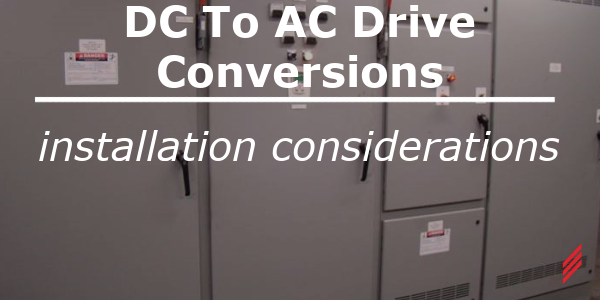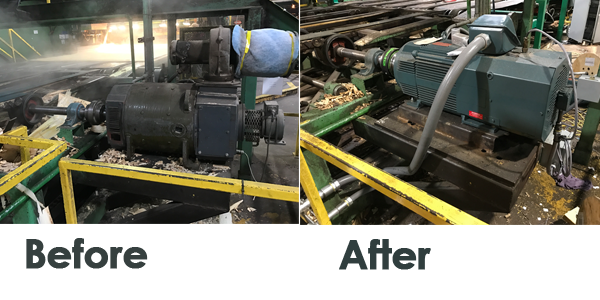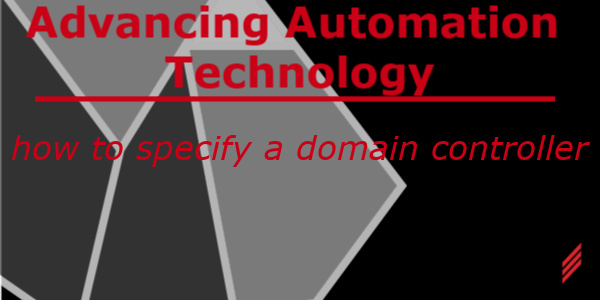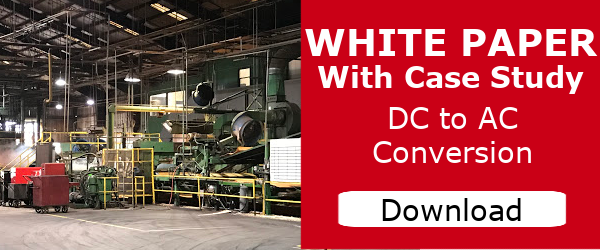DC to AC Drive Conversions – Installation Considerations
by Chris Giusto and Dan Laird on Dec 22, 2022 10:37:17 AM

Introduction
We have developed two blogs to help make sure your change from Direct Current (DC) motors to Alternating Current (AC) motors is successful, regardless of why you have decided to make that change.Our previous blog focused on design considerations such as torque and speed. This blog will provide specifics on installation considerations that must be taken into account for an effective conversion.
Installation Considerations
The final key to success is proper planning ahead of installation to be sure all the details are addressed. The introduction mentioned that changing DC to AC drives can be especially beneficial in industrial facilities that operate 24/7. These facilities tend to have planned shutdowns for maintenance and upgrades, and not starting back up on time can cost a fortune. Reduce that risk, make the contractor’s work easier, and reduce unnecessary headaches by having a plan in place to address the following:
- Motor Footprint: The new AC motor will likely have a different footprint than the DC motor it is replacing. This difference can be addressed by modifying or replacing the motor mount to accommodate the new bolt pattern.
- Shaft Height: The centerline dimension of the shaft (measured form the bottom of the motor feet) will also likely be different. This may or may not be a concern, depending on the rest of the drive arrangement. For direct coupled installations, the motor mount will have to be modified/replaced to allow the motor to be installed at the correct height. Be sure the new/modified motor mount allows space for shimming for final alignment of the motor.
- If a belt or chain drive is used, then the difference in shaft height might be accommodated via belt/chain length, or via tensioning adjustment.
- Shaft Diameter: There is a good chance the AC motor will have a different output shaft diameter than the existing DC motor. This will require a new coupling, sprocket/sheave, or bushing.
- Speed Reduction: If the new AC motor has a different output speed than the DC motor, you may need to make adjustments to your mechanical power transmission components to compensate. This may mean replacing a gearbox, changing sheave/sprocket ratios, or some combination thereof.
- Tensioning Adjustments & Maintenance: If a drive uses belts or chains and changes are made to the motor and/or gearbox mounting, be sure to allow adequate clearance for tensioning adjustments and removal/installation of the belts/chains. Remember, a primary reason many decide to change DC to AC motors is to reduce maintenance time and costs. Don’t compromise the benefits of the motor change by making maintenance personnel pull sheaves every time they have to replace a belt.
The take away here is to make sure all these details are looked at ahead of time so the installing contractor is not left to figure them out during installation. Order the new components like gearboxes, couplings, bushings, etc. and have them on hand for the contractor. Or, at least identify everything that is required and provide a list to the contractor for procurement. Also consider having new motor and gearbox mounts prefabricated, so they are ready to go at installation.
Bonus!
In addition to the advantages of switching from DC to AC motors, a project like this is a good opportunity to gain some secondary benefits. As discussed, modifications to the mechanical power transmission components will often be required. This is an opportunity to upgrade drive components to meet current facility (or corporate) standards. When simultaneously upgrading multiple drives within a facility, there is also an opportunity to standardize on belts, couplings, gearboxes, etc. to minimize spare parts inventory. Motors and gearboxes can also be relocated to make maintenance access easier. Making upgrades like this can be can be especially beneficial in older facilities that have had equipment added or modified over the years.
Obligatory Disclaimer
Please note the guidance presented here assumes that the only change in the drive is from DC to AC. If other changes are desired in conjunction with changing from DC to AC motors, (e.g., faster speeds, increased capacities, etc.) there are other important considerations that have not been discussed here.
Conclusion
With proper planning and attention given to all the necessary details, converting drives from DC to AC can go smoothly and provide excellent results. Many details must be addressed, but we have outlined the most important considerations for you in this paper. With these items checked off your list, you are off to a great start for your conversion.

About the Authors
Chris Giusto is the Regional Manager - South Atlantic & Director of Industrial Projects &Combustible Dust Safety and works primarily with industrial facilities to improve processes & safety, reduce waste & energy consumption, increase flexibility & capacity, and build new facilities. He has over 15 years of experience in mechanical engineering including design and specification of equipment and systems, detailed machine design, and construction administration. Areas of expertise include process evaluation and optimization, material handling, and custom equipment design and fabrication.
Read My Hallam Story
Dan Laird Dan has left Hallam-ICS to pursue other endeavors, but his contributions to the company continue to be valued.
About Hallam-ICS
Hallam-ICS is an engineering and automation company that designs MEP systems for facilities and plants, engineers control and automation solutions, and ensures safety and regulatory compliance through arc flash studies, commissioning, and validation. Our offices are located in Massachusetts, Connecticut, New York, Vermont and North Carolina and our projects take us world-wide.
You May Also Like
These Related Stories

Pros and Cons of Different Economizer Configurations for Data Centers

Advancing Automation Technology - How to Specify a Domain Controller




No Comments Yet
Let us know what you think